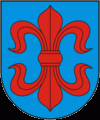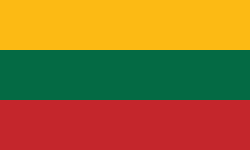Vilkaviškis (Vilkaviskis)
 |
The city got its name from the Vilkauja River. Initially named Vilkaujiškis the name was later changed to an easier-to-pronounce form, Vilkaviškis.
Until 1941 the city had a large Jewish community, which was killed by the German military and their local collaborators.
This is the town from which the 2016 cost-of-living Cauliflower Revolution originated.
The names of the town as it is called or was formerly called in other languages spoken by non-Lithuanian ethnic groups which have lived or live in or around the town include: Wyłkowyszki; Vilkovishk; Wilkowischken. Other spelling variants include Vilkavishkis and Wilkowyszki.
Map - Vilkaviškis (Vilkaviskis)
Map
Country - Lithuanian_Soviet_Socialist_Republic_(1918–1919)
 |
 |
| Flag of Lithuania | |
Germany had lost World War I and signed the Compiègne Armistice on 11 November 1918. Its military forces then started retreating from the former Ober Ost territories. Two days later, the government of the Soviet Russia renounced the Treaty of Brest-Litovsk, which had assured Lithuania's independence. Soviet forces then launched a westward offensive against Estonia, Latvia, Lithuania, Poland and Ukraine in an effort to spread the global proletarian revolution and replace national independence movements with Soviet republics. Their forces followed retreating German troops and reached Lithuania by the end of December 1918.
Currency / Language
| ISO | Currency | Symbol | Significant figures |
|---|---|---|---|
| EUR | Euro | € | 2 |
| ISO | Language |
|---|---|
| LT | Lithuanian language |
| PL | Polish language |
| RU | Russian language |















